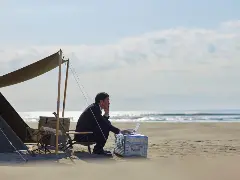

As Florida braces for impending Hurricane Milton, which will cause enormous widespread damage, we decided to take a look back at some of the worst hurricanes our nation has seen over the last one hundred years.
Hurricanes have long been a part of life for those living along the U.S. coastline. While advances in weather prediction have saved countless lives, the sheer power of these storms still leaves a devastating mark. Over the last century, some hurricanes have stood out for their incredible destruction, loss of life, and historical significance.
Below are arguably the five worst hurricanes to hit the United States in the last one hundred years.
1. Hurricane Katrina (2005)
Arguably the most infamous hurricane in recent memory, Hurricane Katrina caused catastrophic damage when it struck the Gulf Coast in August 2005. A Category 5 storm at its peak, it made landfall as a strong Category 3 near Buras, Louisiana. The storm surge overwhelmed the levees protecting New Orleans, leading to widespread flooding.
- Damage: Over $125 billion in damages, making it the costliest hurricane in U.S. history.
- Fatalities: More than 1,800 lives lost, with most of the deaths occurring in Louisiana and Mississippi.
- Impact: Nearly 80% of New Orleans was flooded, and the disaster led to a reevaluation of federal and local emergency preparedness.
2. Hurricane Andrew (1992)
Hurricane Andrew was a compact but incredibly powerful storm that slammed into South Florida on August 24, 1992. Initially a Category 4 storm, Andrew strengthened into a Category 5 just before landfall, producing winds of up to 165 mph. It was the most expensive natural disaster in U.S. history at the time.
- Damage: $27 billion in damages, with 63,000 homes destroyed.
- Fatalities: 65 deaths, directly and indirectly related to the storm.
- Impact: Andrew exposed weaknesses in building codes and emergency response, leading to stricter building standards in Florida.
3. The Labor Day Hurricane (1935)
The Labor Day Hurricane of 1935 remains one of the strongest storms to ever hit the U.S. The Category 5 hurricane made landfall in the Florida Keys on September 2, 1935, with winds estimated to be as high as 185 mph. It is the first Category 5 hurricane to hit the mainland U.S. and still holds the record for the lowest central pressure in a landfalling storm.
- Damage: While the storm caused significant damage, its remote location spared more populated areas. Still, it devastated the Florida Keys.
- Fatalities: Around 400 people died, including hundreds of World War I veterans working on the Overseas Highway.
- Impact: The storm is remembered for its ferocity and the heartbreaking loss of life, particularly among the veteran workers.
4. Hurricane Maria (2017)
Hurricane Maria devastated Puerto Rico when it made landfall as a Category 4 storm on September 20, 2017. Though Puerto Rico is a U.S. territory and not a state, the scale of the destruction and its long-term effects place Maria on this list. Maria crippled the island’s infrastructure, leaving millions without power, clean water, or access to medical care for months.
- Damage: Estimated damages were around $90 billion, making it one of the costliest hurricanes in U.S. history.
- Fatalities: Officially, over 3,000 deaths were linked to the storm and its aftermath, though the true number is likely higher due to the collapse of the healthcare system.
- Impact: The federal response to Maria was widely criticized, prompting changes in disaster response policies.
5. Hurricane Harvey (2017)
Hurricane Harvey made landfall in Texas in August 2017 as a Category 4 storm but is best remembered for the unprecedented flooding it caused in the Houston metropolitan area. Harvey stalled over southeast Texas, dumping record-breaking rainfall—up to 60 inches in some areas—leading to catastrophic flooding.
- Damage: Over $125 billion in damages, tying with Hurricane Katrina as the costliest U.S. hurricane.
- Fatalities: 107 people died as a result of the storm, mostly from flooding.
- Impact: Harvey’s flooding was a wake-up call about the dangers of slow-moving storms, sparking debates about urban planning and flood infrastructure.
These five hurricanes were not only natural disasters but also major turning points in how the U.S. prepares for and responds to such events. The devastation left behind reminds us of the raw power of nature, while the lessons learned have helped shape policy, infrastructure, and public awareness. While we can’t prevent hurricanes, we can work to minimize their impact and protect lives when the next big storm inevitably arrives.








Comments
Post a Comment